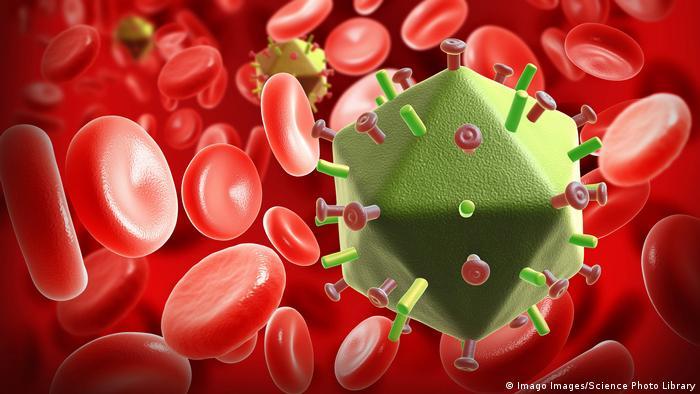40 Years of HIV/AIDS: The Progression of a Pandemic

Our immune systems — and vaccines — find it difficult to attack the 3-dimensional surface structure of HIV
It was in June 1981 that American doctors first started writing about an unknown illness that appeared to be affecting young homosexual men. Those men had been healthy. They had no other, existing conditions. But before we knew it, HIV/AIDS would become the most deadly pandemic of the late, last century.
A rare lung disease causes concern
At the start of the pandemic, most cases of HIV/AIDS were treated as a rare form of a lung inflammation. Patients presenting with this new illness had a fever. But they also presented with swollen lymph glands, a weakened immune system and Kaposi's sarcoma — a type of cancer that causes skin lesions.
Most patients — male and female — died as a result.
And in 1982, the illness got a name: AIDS, or Acquired Immune Deficiency Syndrome.
Scientists isolate the virus
In 1983, Luc Montagnier and Françoise Barré-Sinoussi isolated the virus. The two French virologists, working at the Institut Pasteur in Paris, won the Nobel Prize for Medicine in 2008. That lead to a bitter dispute with an American researcher called Robert Gallo, who claimed the discovery as his until he withdrew that claim in 1991.

The virus up close, under a microscope
However, it wasn't only about the discovery or the Nobel Prize. It was also about the patent or copyright on an antibody test that detected HIV infections. That test hit the mainstream in 1984 and showed that the virus was affecting more and more people.
Viruses do not discriminate
It wasn't long before the virus started to spread internationally. The first cases in Germany were diagnosed in 1982.
Then information started to emerge that the virus was affecting famous musicians, photographers and actors, including Hollywood star Rock Hudson. Hudson died of HIV/AIDS in 1985 and it's said that that changed the public's perception of the condition.
By the end of the 1980s, other prominent people were speaking publicly about their experiences living with HIV. But most average HIV-positive people — those without fame and celebrity — experienced discrimination and social stigma.

At the start of the pandemic, some people got infected via blood transfusions
AIDS becomes a pandemic
Infection rates continued to rise. Most infections were traced back to sex. Some were also traced to blood transfusions.
And while the condition may have started off affecting only same-sex partners, it wasn't long before mixed sex couples were affected as well.
That again changed the public's perception of HIV/AIDS and sexual interactions as the 20th century began to close — as if it was the end of "free love" forever. People were scared of getting infected. Condoms became a currency of sex, and still today they are seen as one of the best ways to protect yourself.
HIV and AIDS are not the same
When HIV enters the bloodstream, it attacks the human immune system so severely that it is unable to fight off any other viral or bacterial infections.
If HIV goes untreated, people can develop AIDS, and that can lead to serious illness.

Kaposi's Sarcoma is a common condition associated with AIDS
Those conditions can include lung inflammation, fungal infections in the esophagus or wind-pipe, and cancer, such as Kaposi's Sarcoma.
But if HIV is treated early enough, it is possible to avoid the risk of AIDS developing and symptoms can even be reversed.
AIDS is a global problem
By the time the United Nations introduced World AIDS Day in 1988, the pandemic had spread to more than 100 countries.
Since then, World AIDS Day has been marked each year on December 1 and adopted a special motto. In 2021 that motto is "End inequalities. End AIDS. End pandemics."
AIDS has hit African countries hardest. Healthcare professionals on the continent often lack the medication to treat people.
Two-thirds of all the world's HIV infections are with people living in Africa — that's 25.5 million people. About 2 million of those infected people are under the age of 15.
In Sub-Saharan Africa, AIDS is the most common cause of death. The countries worst affected by HIV/AIDS include Swaziland, Botswana, Lesotho, Malawi, Namibia, Nigeria, Kenya and Zimbabwe.
The highest rates of infections are in South Africa, where over 7 million people sick with AIDS live. About 320,000 of those are children. Experts say it will take global action to get that epidemic under control.

People in Africa are especial affected by HIV/AIDS
In Africa, HIV-negative people need better information about the virus and HIV-positive people need better therapeutic help.
But many people there still face discrimination and social stigma. As a result, many prefer not to get tested.
Antivirals: An important breakthrough
In 1996, the story of AIDS research took a major turn — one that led to a lot of hope.
At an International AIDS Congress, researchers presented a combination antiretroviral therapy that could slow or stop the virus. A number of medicines are combined to fight the virus — to stop it replicating in the body — and stop AIDS from developing.
The combination antiretroviral therapy is now a standard treatment for HIV. People have to take the medication for the rest of their lives because it doesn't necessarily remove the virus from the body. It manages the virus, rather than cures the person.
But the combination therapy can reduce the so-called viral load to such a low level that in some cases it is no longer detectable in the body.
That also means that people with HIV, who are receiving treatment, will no longer infect other people. And HIV/AIDS is no longer the "death sentence" people once feared.

Antiretroviral drugs have help people live with HIV, rather than die as a result of it
PrEP brings hope
In 2016, the European Medicines Agency (EMA) approved a medicine called Truvada for use as a pre-exposure prophylaxis (PrEP).
So, people can now take PrEP to protect themselves against HIV. But the drug is primarily offered for people who are considered to be at a higher risk than others, such as men who have sex with men.
PrEP consists of two HIV medicines, taken before sexual intercourse. If it's taken daily, it can reduce the risk of an infection by over 95% — but it does not protect against other sexually transmitted infections. For that, condoms are still your best protection.

Social marginalization hinders the fight against AIDS
UNAIDS sets ambitious goals
UNAIDS — the United Nations body that works on HIV/AIDS — set itself and the world an ambitious goal that it called 90-90-90. And it wanted to achieve the goal by the year 2020.
90-90-90 means 90% of all people living with HIV will know their HIV status, 90% of all people with a diagnosed HIV infection will receive sustained antiretroviral therapy, and 90% of all people receiving antiretroviral therapy will have viral suppression.
On the first two counts, we managed to get to 84% by 2020. On the final count, we got to 66%. So, we failed. And the target has been moved to the year 2030.
International organizations against AIDS
Studies suggest that many people still don't know the difference between HIV and AIDS. That includes lots of young people. So, there's an ongoing need for public outreach — raising awareness and knowledge about the virus and its effects.
Many organizations have made that their goal. The International AIDS Society, for example, was founded in 1988 and is now one of the biggest of its kind with members in 170 countries. In Germany, there's "Deutsche Aidshilfe" which was founded in 1983 by a nurse and a group of gay men.

The red ribbon has been a symbol of solidarity for HIV and AIDS since 1991
Many myths remain
To this day, some people believe that HIV is transmitted through the air or just things you do in daily life. That's why some people still keep their physical distance from people with HIV — they wouldn't want to drink out of the same cup as someone living with HIV, or hold other notions about the virus' transmission that are false.
It's myths like these that continue to stigmatize and marginalize people living with HIV, as well as discourage people from speaking openly about it.
HIV/AIDS is now one of the most manageable conditions in society.
Waiting for a vaccine
It's difficult to develop a vaccine against HIV. The virus has a three-dimensional surface structure, making it hard for our immune systems — or a potential vaccine — to handle.
The immune system has to be able to recognize its opponents. But HIV changes quite a lot and that makes it harder still. HIV tricks the immune system and seems to be permanently one step ahead of research.
So, until researchers find a vaccine, our best protection is, as always, safe sex and treatment with antiretroviral medication.
This article was translated from the original German text by Zulfikar Abbany. Editor: Louisa Wright.
Get the latest reports & analysis with people's perspective on Protests, movements & deep analytical videos, discussions of the current affairs in your Telegram app. Subscribe to NewsClick's Telegram channel & get Real-Time updates on stories, as they get published on our website.
























